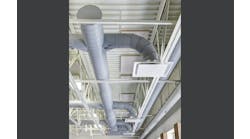When a problem affects one out of every 13 children, it clearly is an issue that schools must address.
According to the U.S. Environmental Protection Agency (EPA), that is the incident rate for asthma among the nation's children. The inflammatory disease causes a person's airways to constrict, leading to wheezing, breathlessness, chest tightness and coughing.
As part of its Indoor Air Quality “Tools for Schools” program, the EPA has put together a guide, “Managing Asthma in the School Environment,” to help reduce the incidence of the disease.
“Since children spend most of their time in schools, day care facilities, or at home, it is important to reduce their exposure to environmental asthma triggers as much as possible in each of these environments,” the EPA says.
The guide states that the best strategy for managing a child's asthma is to address both the medical management of the disease and avoidance of environmental triggers. Common triggers found in schools include cockroaches and other pests, mold resulting from excess moisture in a building, dander from animals, secondhand smoke and dust mites. In addition, the guide says, some health advocates believe that products used in schools — cleaning agents, perfumes and sprays, for example — can trigger asthma episodes.
The guide lists 10 ways to manage asthma in schools:
-
Use the IAQ “Tools for Schools” kit.
-
Control animal allergens. Remove classroom animals from the school, if possible. If not, place them away from sensitive students and ventilation systems.
-
Control cockroach allergens. Use integrated pest-management practices to prevent cockroach and other pest problems. Store food in tightly sealed containers, and place dumpsters away from the building.
-
Clean up mold, and control moisture. Fix moisture problems and thoroughly dry wet areas within 24 to 48 hours to prevent mold growth. Clean up hard, moldy surfaces with water and detergent, and then dry thoroughly.
-
Eliminate secondhand smoke exposure.
-
Reduce dust mite exposure. Make sure school facilities are dusted and vacuumed thoroughly and regularly.
-
Develop an asthma management plan for your school. Include school policies on inhaler and other medication usage, and emergency procedures for school staff to follow when a student experiences an asthma attack.
-
Provide school-based asthma-education programs.
-
File student asthma action cards. Encourage students to work with their healthcare providers to identify their asthma triggers. Make sure students with asthma turn in copies of Asthma and Allergy Foundation of America action cards to their teachers and school nurses.
-
Gather additional asthma information and resources. Establish a file on existing asthma and allergy-related information sources to use as a reference during the school year.

